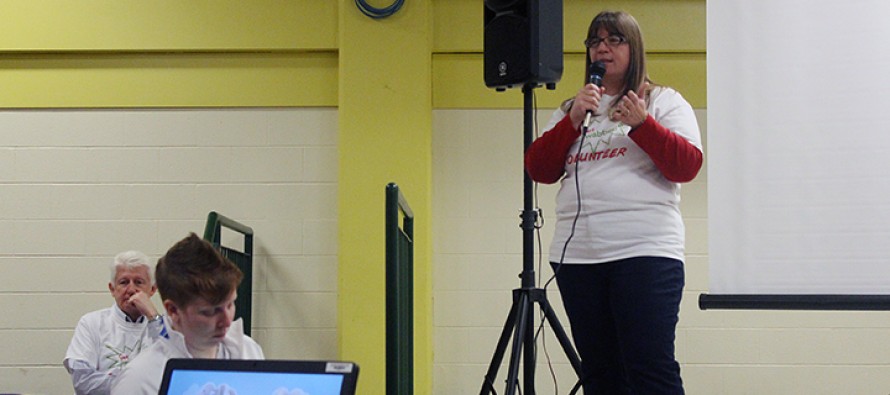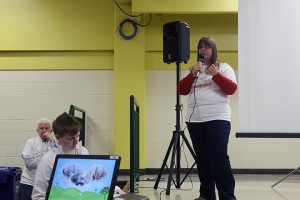OneMatch gives a second chance

By Lyndi-Colleen Morgan

Joanne Bedard (right) tells the story of her daughter Katelyn at the swab event at St. Clair College on Jan. 28. She also thanked the participants of the event for becoming part of the registry. Photo by Lyndi-Colleen Morgan
Young males are the most needed stem cell donors but currently make up less than one-quarter of the total registry, according to OneMatch, the national stem cell and marrow network.
In 2015 data from OneMatch found male donors ages 17 to 35 represented 17 per cent of the current Canadian donor database. Men are needed more than females because their stem cells are more likely to be compatible with their recipients.
Stem cells are the immature cells not been assigned a function. They can become red blood cells which carry oxygen, white blood cells which fight infection or platelets which help stop bleeding. This is what is extracted from the donor and can be obtained from the bone marrow which is a rich source of cells. It can also be taken from the circulating blood. These stem cells can be used to treat leukemia, aplastic anemia and inherited immune system and metabolic disorders.
OneMatch encourages anyone in “good standing health” and between the ages of 17 and 35 to become part of the donor registry but they are requiring more male donors because of the benefits their stem cells offer.
“Male donors are more compatible with their recipients because the cells are more adaptable and heal quicker,” said Joanne Bedard, co-founder of the Katelyn Bedard Bone Marrow Association. “There is also less chance of graft-versus-host disease between the donor and the recipient. Graft-versus-host is when the donor’s cells attack the recipient’s body, which can be caused by women who have a history of pregnancy. Due to this, male matches will be chosen over female matches most times.”
Bedard and her husband Bryan founded the Katelyn Bedard Bone Marrow Association in July 2005 after their daughter Katelyn, 3, died of leukemia when no match could be found for her.
The association’s mission, said Bedard, is to promote awareness and education about bone marrow and stem cell registries, to bring attention to the need of donors and to encourage people to join the registry. She also said their organization aspires to give support to families with a family member in need of a transplant.
“Our organization helps to build the registry of donors and sponsor research projects working on stem cell transplants and treatment methods. We also provide support to families who have family members who will be receiving a transplant,” said Bedard. “ Donors help to provide a second chance to those who may not get it other ways and being aware is the first steps in the donation process.”
Donor Tessa Shawman said she gave someone a second chance in November 2014 with her stem cell donation. She became part of the registry in 2011 at a swab event held at St. Joseph’s High School in Windsor.
She said her process to become a donor was shorter than most. The process can take three months but she was prepared and ready for the donation in three weeks. Donations can be taken in two form — through peripheral blood stem cell donation or through bone marrow stem cell donation surgically. Shawman donated through the stem cell bone marrow extraction process.
Shawman said the extraction method was not too painful but it was uncomfortable. Although it did cause her some discomfort she said she would not change anything about the experience.
“My first few days post-surgery were super uncomfortable but not unbearable,” said Shawman. “Although my healing took a little longer than expected, if I had to do it all over again, I wouldn’t do anything differently.”
She also said she believes people should consider registering as a donor because there is little risk for the donor and they could potentially save someone’s life.
In 2010, Alex Tetreault was diagnosed with leukemia at the age of 18 and shortly after being diagnosed was placed on the recipient transplant list. He went through 11 bone marrow extractions to help find a match but he never received a transplant because the chemo treatments worked.
In 2013, Tetreault was told by doctors he was cancer free and has been in remission for the last three years.
He became part of the donor registry Jan. 28 and said it is his way of giving back.
“People should help other people, and becoming part of the donor registry helps,” said Tereault. “I mean if people don’t volunteer, give blood, or give bone marrow, people like me, wouldn’t be here.”
Bedard said when individuals become part of the Canadian registry they become eligible to donate to the international registry and this is one thing to consider before becoming a donor.
Those eligible to donate can become part of the registry at swab events or through Canadian Blood Services. For more information about becoming part of the OneMatch stem cell and marrow network, visit www.onematch.ca.


